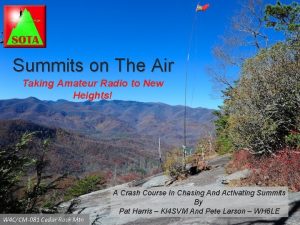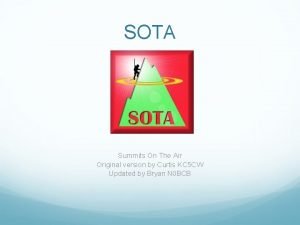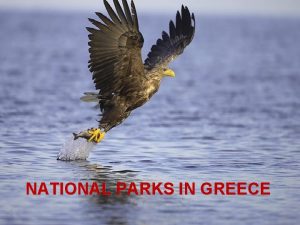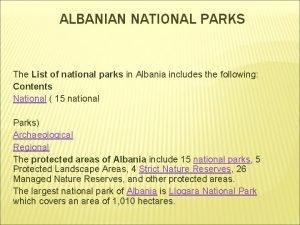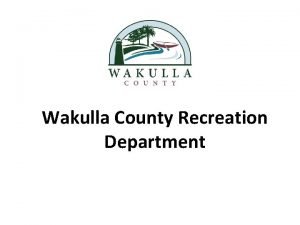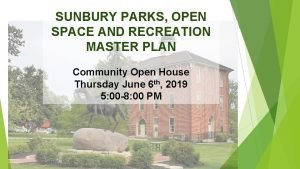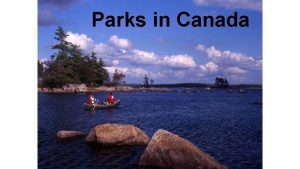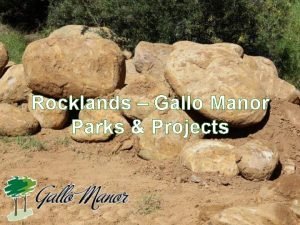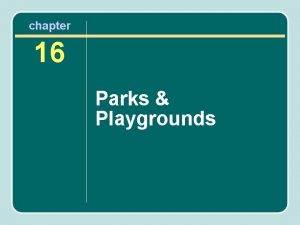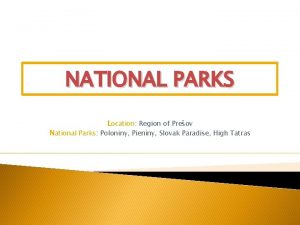National Parks on the Air NPOTA and Summits







- Slides: 7

National Parks on the Air (NPOTA) and Summits on The Air (SOTA) Quick summary and lessons learned N 6 MDV September 20, 2016

Summary • Week long camping trip to multiple national parks – – Kings Canyon Lassen Volcanic Redwood Pinnacles • Brought Elecraft KX-2 radio and amplifier – NPOTA activations from campgrounds – Park Ridge W 6/SS-354 summit activation < 4 mile hike • Activated 3 of the parks and the summit • Sharing experience and lessons learned…

NPOTA 100 th Anniversary Celebration National Park Service • ARRL event – Activators and Chasers – Points each time contact or activate a park Redwood National Park Just 10 QSO’s 24 QSO’s 49 QSO’s

Simple Setup – lightweight, portable • Elecraft KX-2 transceiver with KXPA-100 amplifier • 66 foot dipole AWG 26 wire roughly 5 -7’ above ground – 40 M NVIS • 35 foot RG 174 coax with BNC connectors – Tucked into space available within camp site 40 M contacts from west coast to east coast! Used 90 AH 12 V battery for power

• Summits On The Air International program operate from peaks – Activators and Chasers – Points awarded based on altitude of peak and season climbed – No operation from cars or generators – hike or bike • Park Ridge (W 6/SS-354) 2 mile easy hike in Kings Canyon NP – Near Azalea campground – Never been activated before this trip! • Eight contacts on 2 M FM – one as summit to summit – Hand held likely sufficient, but used an Arrow 4 element yagi too • 20 M SSB and CW difficult with all the weekend contests 2 -2. 5 AH batteries QRP HF transceiver CW paddle and mic 5 W HT Log sheet

How to do it… • NPOTA rules and information on ARRL web site – – – Choose a park List your upcoming activation Show up, set up radio, and call CQ Ask someone to spot you on DX cluster Record time, band, call sign, and signal reports • Create a Cabrillo log when you are back (or ADI format) • Upload your contacts using TQSL – 10 QSO’s activate a NPOTA – Need Log Book of the World (LOTW) certificate to record QSO’s • Again ARRL web site explains how Sample Log book of the world page Shows a completed QSL – both have logged contact

Lessons Learned 1. Really fun to operate with low background noise and people wanting to contact you – NPOTA chasers are very appreciative of activation – Noise near S 0 and contacts nearly one per minute on NPOTA 2. Hands get very dirty setting up antennas in camp or on peak (caked with dirt) – Have water and a cloth to clean up before using radio 3. Spotting on DX cluster helps immensely – DX cluster and NPOTA Face Book – have someone spot you 4. Try not to activate a park during contest weekend 5. Even a modest antenna does amazingly well on non-contest weekends – FL, NC, GA, AL, VA, CT, MT, ID, OR, WA, KS, TX, NY on 100 W dipole at 5 -7 feet 40 M 6. NPOTA activation “friendlier” than contests yet pace is very high – 1 QSO or more per minute with time to say hello, thanks, and … 7. Noise level in Pinnacles NP was S 0 – very nice – Also low in other parks – On the other hand, critter noise can be very loud – crickets, birds, … 8. Quiet time in campgrounds is 8 PM – be courteous – Use headphones/ear buds even before 8 PM – Pre record CQ if radio has that capability so only need to speak unique info 9. Parks may not allow ropes in trees – be prepared with some poles 10. Lock in frequency if radio allows that so don’t accidently drop off frequency
